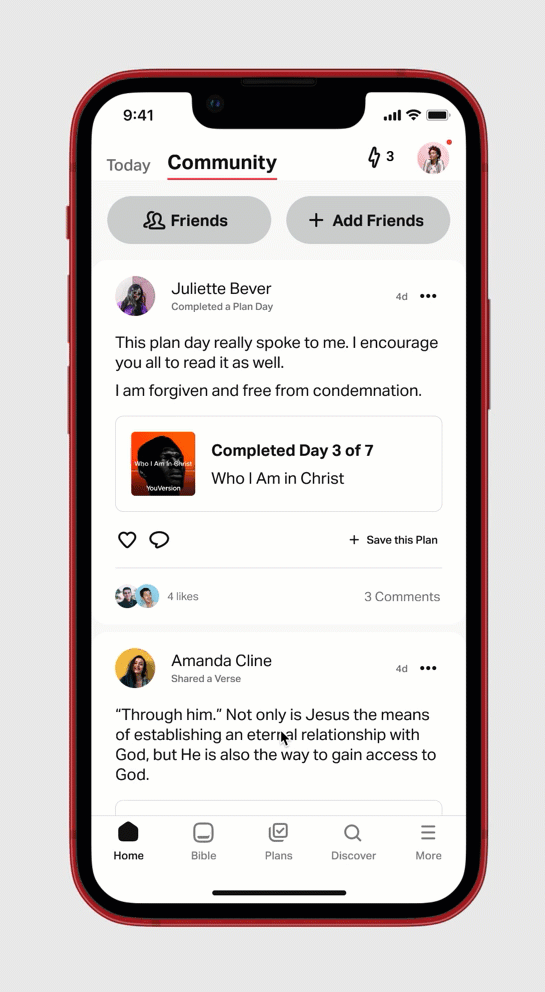YouVersion Community
YouVersion Bible App
This project was completed with Product Manager, Sam Bible, and Product Designer, Jonathan Santiago. The beginning ideation phase was mostly done as a group, while all the UI work is mine.
Oct - Dec 2022
The vision for Christian community within the Bible App
The YouVersion Bible app is a global app with millions of active users but an individual user wouldn’t know this by simply using the app. Our current community feature shows the activity of their friends. It’s auto-posted and some users don’t know their activity is being shared to the feed These posts don’t create interaction between users but instead users ignore the feature all together.
Our goal was to improve community features show users can engage with their community within the app.
Dots indicate users active on the app at the time of the screenshot (1-20-23)
When did users feel most spiritually connected in their life?
When we asked fellow christians, most people talked about the christian community that they had experienced.
Christian community exists outside the app and is naturally happening in churches, small groups, texting group chats and more.
How did users first hear about the YouVersion Bible App?
Over 50% responded by talking about their friends, family and church. This is their community.
And 30% of monthly active users have friends in the app.
If users have Christian community, why is the app not seeing this engagement?
Our community features are broken out in different silos that are totally disconnected experiences.
The community feed includes auto-posted app activity of your friends and it doesn’t create interaction between users
Only 3% of users use the plans with friends feature.
The prayer feature is disconnected from the community feature and has had low adoption.
Events and Churches are hard to find in the the app architecture
Design Solution
How can we help users engage with their community of friends within the app?
Users can now post to the community feed after engaging with different bible content (bible reader, bible plans, videos). This give them the autonomy to decide when and what they want to share with their friends, while also providing meaningful and engaging content to engage with.
Post CTA: The paper airplane icon to indicate to the user where they can start creating a post. This icon is new to this app, but familiar as it it used to indicate internal sharing in other social apps.
Create a post: Each post type will show the user a preview of the content that will be displayed along with the comment they add to the post. Interaction animations to help guide the user to what they need to do to create a post and to start typing.
Posts: Updated the UI of posts to create consistency across all the post types. CTAs o posts help to increase engagement within the feed,
User Testing
Another designer and I interviewed two internal employees and three users who used the community feature in the last 7 days. In the interview, we asked them about their current experience with the community feature and asked them questions about the the new prototypes.
Some recurring problems we found from these users:
Post vs Share problem - When asked how they would post to community? Most users tapped on a share button instead of post.
Power users understand current work arounds/hacks to post to community
Power users like being able to see their friends activity and check in on friends progress - especially for “Baby Christians”
Some positive highlights
“Right now the community feed is restricted to the persons specific activity that day. I would love to see something developed that would be similar to a text thread or a GroupMe type community.”
“Now I can share in detail what a verse means to me!”
“Ahhhh, I love that!”
In general, users felt positively towards the change
Next Steps
After talking with users we determined the need for onboarding. We needed to come up with a simple way to teach users what post means and how it works. We felt that once this concept in introduced more into the app, users will understand by learning.









